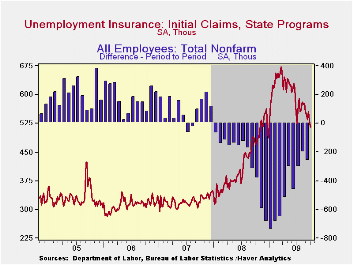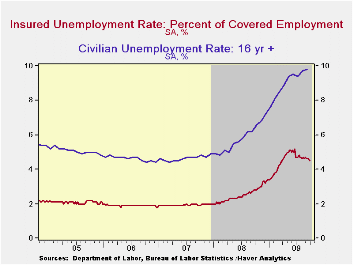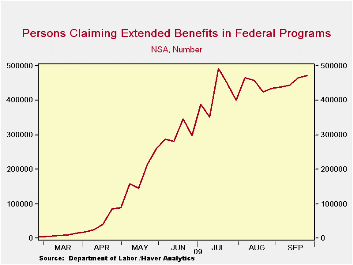 Global| Oct 15 2009
Global| Oct 15 2009U.S. Initial Unemployment Insurance Claims Fall Slightly; Continuing Claims Off As Well
by:Tom Moeller
|in:Economy in Brief
Summary
A recent downtrend in initial claims for unemployment insurance continued last week. They fell slightly and remained near their lowest level since early-January. The Labor Department indicated that claims fell to 514,000 from an [...]
 A recent
downtrend in initial claims for unemployment insurance continued last
week. They fell slightly and remained near their lowest level since
early-January. The Labor Department indicated that claims fell to
514,000 from an upwardly revised 524,000 during the prior week. Both
figures are down sharply from the peak reached in March of 674,000
claims. The latest figure was lower than Consensus expectations for
525,000 claims.
A recent
downtrend in initial claims for unemployment insurance continued last
week. They fell slightly and remained near their lowest level since
early-January. The Labor Department indicated that claims fell to
514,000 from an upwardly revised 524,000 during the prior week. Both
figures are down sharply from the peak reached in March of 674,000
claims. The latest figure was lower than Consensus expectations for
525,000 claims.
The largest decreases in initial claims during the week ending October 3 were in Florida (-5,178), California (-3,911), Tennessee (-683), Illinois (-682), and Arkansas (-589) while the largest increases in claims were in Pennsylvania (+3,618), Washington (+1,857), Wisconsin (+1,629), Missouri (+1,441), and Texas (+1,291).
Continuing claims for unemployment insurance during the latest week
fell 75,000 to their lowest level since late-March. The decline
continues to owe partially to the exhaustion of benefits. Continuing
claims provide an indication of workers' ability to find employment.
The four-week average of continuing claims fell modestly to 6,082,750.
This series dates back to 1966. · Extended benefits
for unemployment insurance rose sharply for the fifth consecutive week.
Through the end of last month, extended benefits averaged 471,031.
The decline
continues to owe partially to the exhaustion of benefits. Continuing
claims provide an indication of workers' ability to find employment.
The four-week average of continuing claims fell modestly to 6,082,750.
This series dates back to 1966. · Extended benefits
for unemployment insurance rose sharply for the fifth consecutive week.
Through the end of last month, extended benefits averaged 471,031.
The insured rate of unemployment slipped to 4.5% and matched its lowest since early-April. The rate reached a high of 5.2% during late-June. During the last ten years, there has been a 93% correlation between the level of the insured unemployment rate and the overall rate of unemployment published by the Bureau of Labor Statistics.
 The lowest rates were in North Dakota (1.0%), South Dakota (1.1),
Virginia (2.1), Wyoming (2.5), Maine (2.5), Texas (2.6), Colorado
(2.9), Minnesota (3.0), Maryland (3.1), Mississippi (3.5), New York
(3.5), Florida (3.8), and Georgia (3.9). The highest insured
unemployment rates in the week ending Sept. 26 were in Puerto Rico (7.1
percent), Oregon (5.3), Nevada (5.2), Pennsylvania (5.0), California
(4.7), Michigan (4.6), North Carolina (4.6), Wisconsin (4.6), Arkansas
(4.5), and South Carolina (4.5).
The lowest rates were in North Dakota (1.0%), South Dakota (1.1),
Virginia (2.1), Wyoming (2.5), Maine (2.5), Texas (2.6), Colorado
(2.9), Minnesota (3.0), Maryland (3.1), Mississippi (3.5), New York
(3.5), Florida (3.8), and Georgia (3.9). The highest insured
unemployment rates in the week ending Sept. 26 were in Puerto Rico (7.1
percent), Oregon (5.3), Nevada (5.2), Pennsylvania (5.0), California
(4.7), Michigan (4.6), North Carolina (4.6), Wisconsin (4.6), Arkansas
(4.5), and South Carolina (4.5).
The unemployment insurance claims data is available in Haver's WEEKLY database and the state data is in the REGIONW database.
Yesterday's Senate testimony by Fed Governor Daniel K. Tarullo, State of the banking industry, can be found here.
| Unemployment Insurance (000s) | 10/09/09 | 10/02/09 | 09/26/09 | Y/Y | 2008 | 2007 | 2006 |
|---|---|---|---|---|---|---|---|
| Initial Claims | 514 | 524 | 554 | 9.6% | 420 | 321 | 313 |
| Continuing Claims | -- | 5,992 | 6,067 | 59.7% | 3,342 | 2,552 | 2,459 |
| Insured Unemployment Rate (%) | -- | 4.5 | 4.6 | 2.8 (10/2008) | 2.5 | 1.9 | 1.9 |
Tom Moeller
AuthorMore in Author Profile »Prior to joining Haver Analytics in 2000, Mr. Moeller worked as the Economist at Chancellor Capital Management from 1985 to 1999. There, he developed comprehensive economic forecasts and interpreted economic data for equity and fixed income portfolio managers. Also at Chancellor, Mr. Moeller worked as an equity analyst and was responsible for researching and rating companies in the economically sensitive automobile and housing industries for investment in Chancellor’s equity portfolio. Prior to joining Chancellor, Mr. Moeller was an Economist at Citibank from 1979 to 1984. He also analyzed pricing behavior in the metals industry for the Council on Wage and Price Stability in Washington, D.C. In 1999, Mr. Moeller received the award for most accurate forecast from the Forecasters' Club of New York. From 1990 to 1992 he was President of the New York Association for Business Economists. Mr. Moeller earned an M.B.A. in Finance from Fordham University, where he graduated in 1987. He holds a Bachelor of Arts in Economics from George Washington University.






